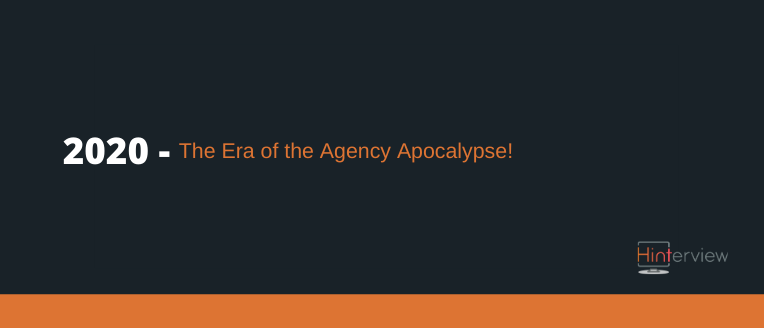2020: The Era of the Agency Apocalypse!

Related articles
Sign up to our newsletter
Sign up nowHow many times has the recruitment agency apocalypse been predicted at this stage? Three? Four? The internet, job boards, LinkedIn & more recently, AI bots were all supposed to kill off the agency recruiter by making us humans redundant. But I don’t care how complex your algorithms are, people know people, and people buy from people. So here we are, alive and kicking.
Did these recent technological advances force us to adapt our way of working? Absolutely, but it didn’t kill our industry. In fact, more recently technology has assisted recruiters in certain areas, breaking down geographical boundaries to candidates, automating menial tasks and aiding a more streamlined approach to market penetration.
The global employment industry is currently worth a massive €491 billion and this is expected to grow well into 2020 because that’s the beauty of the recruitment industry! It’s being constantly threatened by the emergence of new technology but, in reality we evolve, adapt and overcome these threats utilising technology to its full potential.
Or at least most of us do.
The standard tech stack of a trainee recruitment consultant joining Sthree in 2002 consisted of a desktop computer with one system (EasyAccess), a desk phone and a folder of org charts (if you were lucky). Dare to imagine hiring for your business today and offering that as your starter pack? The trainee would have left by the time the internet dialled up!
Looking at the standard tech stack of a trainee recruiter today is more like looking at a spy kit with systems to organise, track, source, find and screen the ideal candidate. A mobile as standard, laptop, tablet, CRM and a host of software of which the list is practically never ending and yet, still growing!
Don’t believe us? Lucky for you we control tested it with the youngest members of the Hinterview team. The control being anyone over the age of 25 while the “babies” of the group made for a much better watch!
With an ever-changing technology landscape and demands from clients increasing, it can be hard to know where to start. But here’s a word of warning, if you’re still stuck at the “where to start” phase, just start! Because you’re almost too late.
The rate that technology is coming onto the scene is unparalleled to anything we have seen before but, what’s even more alarming is the rate in which we are adopting technology. The radio took 38 years to reach a market audience of 50 million. The television took 13 years and the iPod only took 3 years to reach a market audience of 50 million.
“How does that tie into recruitment?” I hear you ask. Well it’s simple really. Your competitors are embedding and utilising technology that is speeding up their workforce while you’re sat over there tuning in FM 104 to make sure you catch the job ads section.
So, where do you start. How do you navigate your way through this unknown technology jungle and how do you assess what technology is actually important for your business?
Ultimately that’s dictated by you and your business needs which sounds simple, but a lot of people get caught up in the next tech trend without considering “why” it’s going to be of benefit.
There are a couple of things to consider when looking at improving your tech stack; a checklist if you will.
- What am I trying to improve?
Whether it be a workflow or removing those administrative heavy tasks from your biggest biller, make sure you address this question keep the answer at the forefront.
- By embedding “X”, what improvements do I expect to see?
Set your own expectations. If you’re taking the time, money and effort to embed a new piece of technology into your business have a clear picture of what you want the objectives to be. Nobody likes taking on a cool, sexy piece of tech which nobody sees the benefit in. It’s futile.
- Will “X” make me more money or save me money?
These two lines are often crossed but there is a clear difference. Some pieces of tech can help you save money i.e. Accounting Software removing some payroll admin negating the need for an extra support staff member. Other pieces of tech can make you money i.e. Hinterview allowing your recruiters to offer a premium service (wink, wink!). Both saving and making money are positives when looking at your business, but it is important to know which one you are trying to achieve with each piece of tech you’re implementing into your business.
My best advice is to audit your business and be harsh on yourself. A business rarely improves by looking at all the things you do great and congratulating yourself on them (though there is a time and a place for that!). Actively look for inefficiencies, gaps in process, sweet spots of inadequacy and then apply the checklist to each of the areas you identify as weak. If a piece of tech can satisfy them, then it’s time to start signing contracts.





